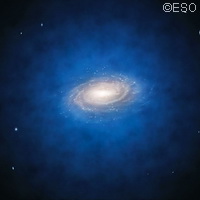Scientists find no dark matter around Sun
Space scientists have challenged a long-held belief that the solar neighbourhood is home to an extensive amount of dark matter, an invisible and mysterious substance that can only be identified indirectly by the gravitational force it exerts. According to this latest study, which is the most accurate study to date, what researchers have believed through time is not observational fact. The finding suggests that measures to directly detect dark matter particles on our planet are not likely to bear fruit. Researchers led by the Universidad de Concepción in Chile used the MPG/ESO 2.2-metre telescope at the La Silla Observatory of the European Southern Observatory (ESO) and other telescopes to map the motions of over 400 stars up to 13,000 light-years away from the Sun. They measured the mass of material in the area around the Sun. 'The amount of mass that we derive matches very well with what we see - stars, dust and gas - in the region around the Sun,' says Christian Moni-Bidin from the Department of Astronomy at Universidad de Concepción. 'But this leaves no room for the extra material - dark matter - that we were expecting. Our calculations show that it should have shown up very clearly in our measurements. But it was just not there!' Many researchers say dark matter played a critical role in how the outer parts of galaxies, such as our own Milky Way, rotated so quickly. But many also postulate that dark matter was instrumental in forming and evolving galaxies. Most scientists postulate that dark matter makes up around 80% of the mass in the Universe. But efforts to shed light on this issue have never been successful. In this latest study, the team determined the volume of dark matter by measuring the motions of the stars. They say the motions are generated by mutual gravitational attraction of all the material, whether normal matter such as stars, or dark matter. They also add that the models available for use to determine the development and rotation of galaxies suggest that the Milky Way is surrounded by a halo of dark matter. It should be noted that researchers have not accurately predicted the shape the halo takes. For this latest study, the researchers say unlikely shapes for the dark matter halo are needed in order to explain the lack of dark matter. This is the case for their study. According to the team, it is hard to detect dark matter on our planet if you attempt to identify the rare interactions between dark matter particles and 'normal' matter. Dr Moni-Bidin concludes: 'Despite the new results, the Milky Way certainly rotates much faster than the visible matter alone can account for. So, if dark matter is not present where we expected it, a new solution for the missing mass problem must be found. Our results contradict the currently accepted models. The mystery of dark matter has just become even more mysterious. Future surveys, such as the European Space Agency Gaia mission, will be crucial to move beyond this point.'For more information, please visit:ESO:http://www.eso.org/public/Universidad de Concepción:http://www.udec.cl/pexterno/
Countries
Chile



